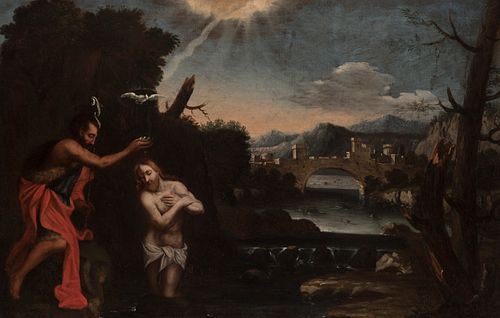Italian school; second half of the 17th century. "The baptism of Christ". Oil on canvas. Re-retouched.
Lot 77
About Seller
Setdart Auction House
Carrer Aragó 346
Barcelona
Spain
Setdart Subastas was born in 2004 and is currently the first online art auction in Spain with solidity, prestige and reliability guaranteed by our more than 60,000 users. Setdart has a young, dynamic and enterprising team ready to successfully manage the purchase and sale of art works through custom...Read more
Estimate:
EUR€10,000 - EUR€12,000
$10,869.57 - $13,043.48
Absentee vs Live bid
Two ways to bid:
- Leave a max absentee bid and the platform will bid on your behalf up to your maximum bid during the live auction.
- Bid live during the auction and your bids will be submitted real-time to the auctioneer.
Bid Increments
| Price | Bid Increment |
|---|---|
| EUR€0 | EUR€10 |
| EUR€200 | EUR€25 |
| EUR€500 | EUR€50 |
| EUR€1,000 | EUR€100 |
| EUR€3,000 | EUR€200 |
| EUR€5,000 | EUR€500 |
| EUR€10,000 | EUR€1,000 |
| EUR€20,000 | EUR€2,000 |
| EUR€50,000 | EUR€5,000 |
About Auction
By Setdart Auction House
Jul 14, 2021
Set Reminder
2021-07-14 06:30:00
2021-07-14 06:30:00
America/New_York
Bidsquare
Bidsquare : OLD MASTERS
https://www.bidsquare.com/auctions/setdart-auction-house/old-masters-7202
Setdart Auction House sofia@setdart.com
Setdart Auction House sofia@setdart.com
- Lot Description
Italian school; second half of the 17th century. "The baptism of Christ". Oil on canvas. Re-retouched. Presents repainting, period narco and frame of the early twentieth century. Size: 88 x 127,5 cm; 68,5 x 108,5 cm (frame). This work shows an idealized natural landscape in the background, with large figures, located in the left area of the composition. In spite of their location in the piece, the figures do not lose prominence, due to their magnitude with respect to the landscape and the tonalities used in their conception. Following the usual aesthetics after the dispositions of the Council of Trent that directed the change of Roman Catholicism in the Counter-Reformation. On the left, dressed in the typical unfinished tanned skin, with his characteristic red cloak, is Saint John the Baptist, pouring water on Christ and with his crosier with phylactery held by his left hand. Christ is dressed only in a cloth of purity and adopts a gesture of humility as he bows his head while holding his two hands clasped on his chest. Iconographically, the theme of the Baptism of Christ is one of the oldest in Christian art because of its theological importance and the Sacrament that derives from it (which is why it has undergone variations that, at times, can be related to liturgical variations in the Sacrament of Baptism). As is logical, it has varied according to the moment, the style and the school to which each work belongs. Spanish Baroque painting is one of the most authentic and personal examples of art, because its conception and form of expression arose from the people and the deepest feelings that nestled in it. With the economy of the State broken, the nobility in decline and the high clergy burdened with heavy taxes, it was the monasteries, parishes and confraternities of clerics and laymen who promoted its development, the works sometimes being financed by popular subscription. Sculpture was thus compelled to embody the prevailing ideals in these environments, which were none other than religious ones, at a time when the counter-reformist doctrine demanded from art a realistic language so that the faithful would understand and identify with what was represented, and an expression endowed with an intense emotional content to increase the fervor and devotion of the people. The religious subject is, therefore, the preferred theme of Spanish painting of this period, which in the first decades of the century starts from a priority interest in capturing the natural, to progressively intensify throughout the century the expression of expressive values, which is achieved through the movement and variety of gestures, the use of light resources and the representation of moods and feelings.
- Shipping Info
-
In-house shipping available. Please inquire at admin@setdart.com.
-
- Buyer's Premium



 EUR
EUR CAD
CAD AUD
AUD GBP
GBP MXN
MXN HKD
HKD CNY
CNY MYR
MYR SEK
SEK SGD
SGD CHF
CHF THB
THB

















